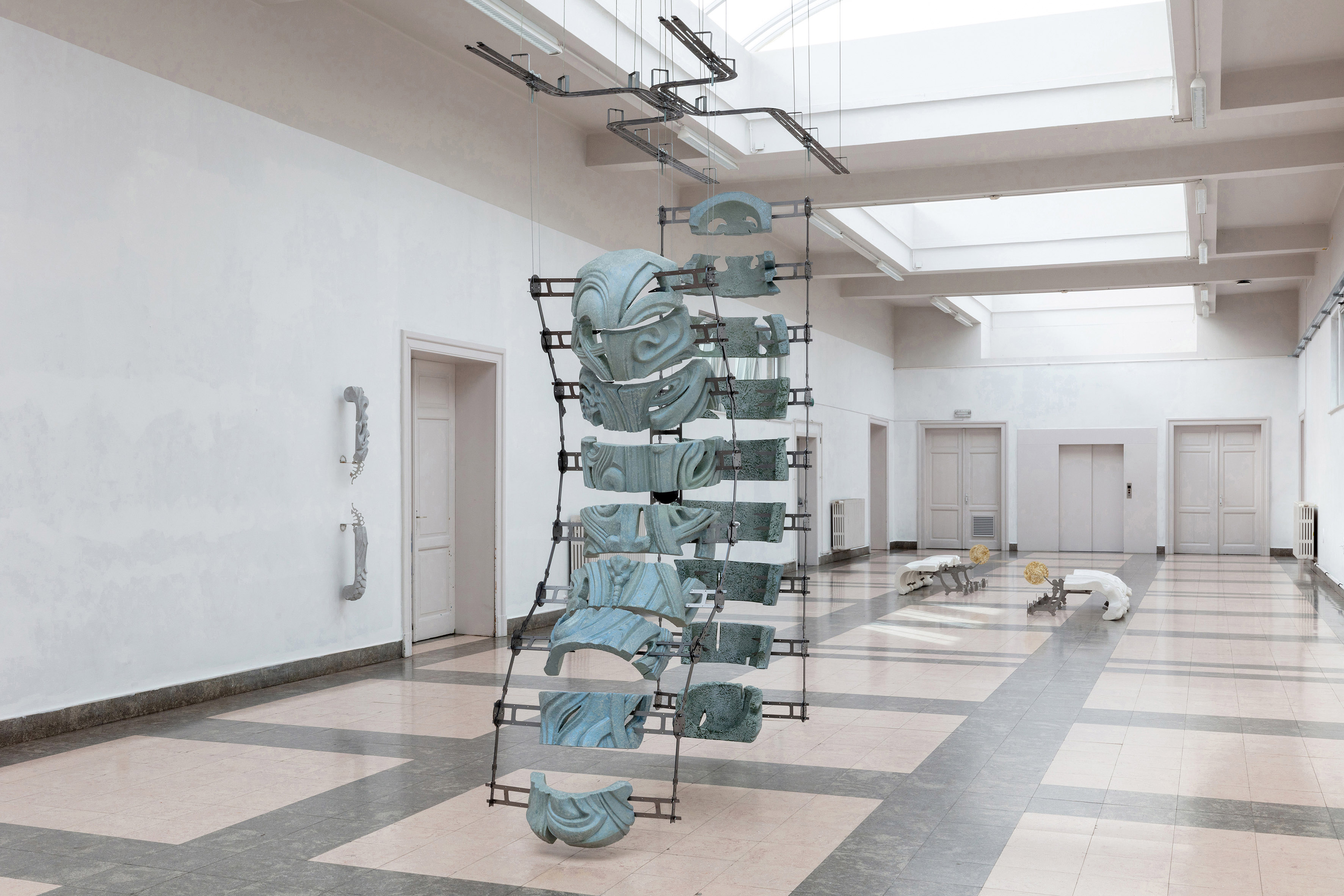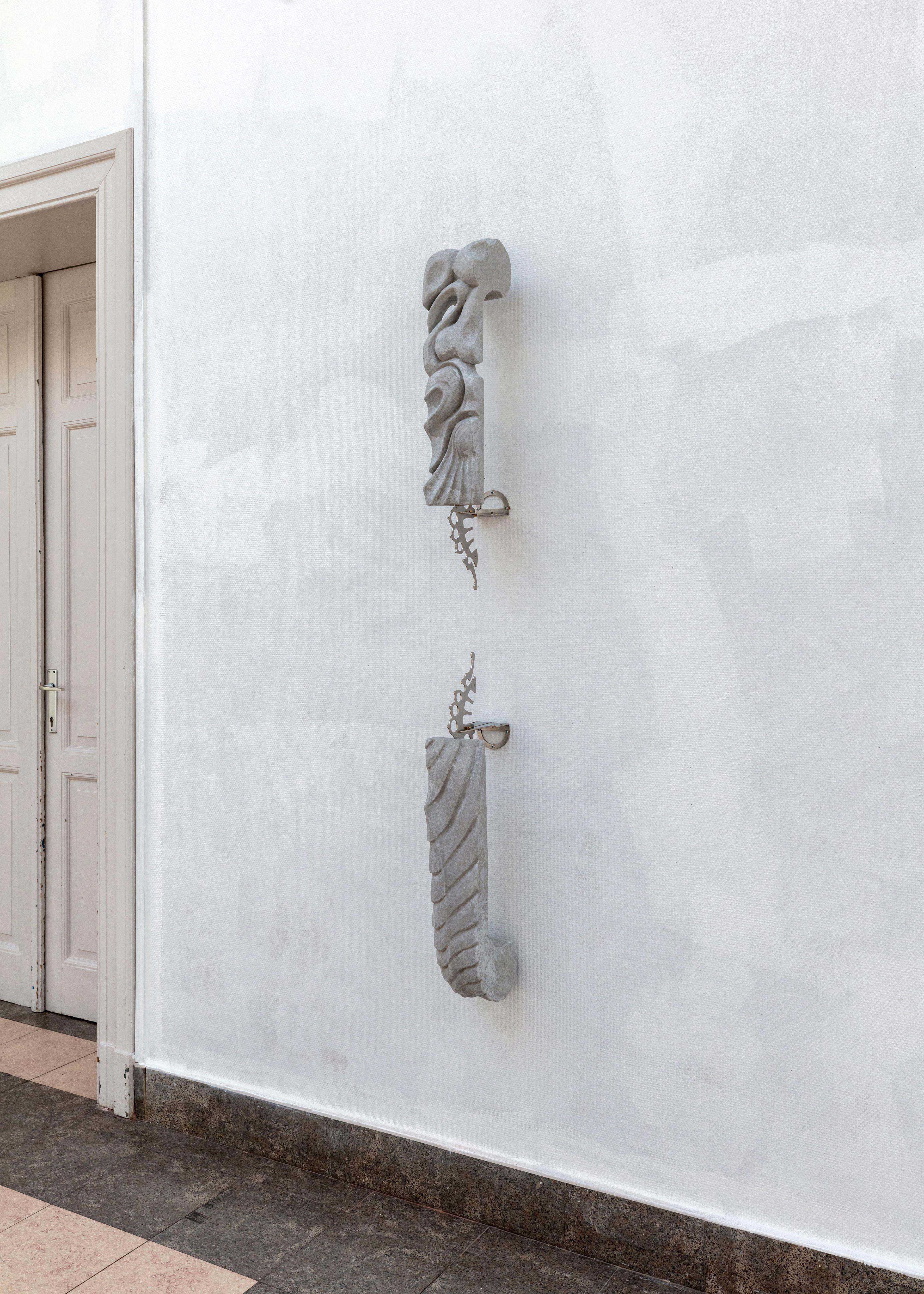YYYYMMDD >>> BACK HOME <<< >>> SELECTED FEATURES <<< >>> INTERVIEWS <<<
[20231108]
SUBCUTANEAN GHOSTS by PAOLA SIRI RENARD at DASH curated by JOACHIM COUCKE [from 20231020 to 20230511]
[Photos: Tim Evers]















Reminiscent of the remains of buildings once excavated and partially reassembled, Paola Siri Renard’s sculptures erect (once again) before us, spread out on the floor, suspended from the ceiling or anchored to the wall, beckoning viewers to confront them. The hybrid union between these architectural ruins and the steel elements supporting them like braces mending a bone fracture yields almost cyborg-like pieces. They are like remains of columns, frontispieces, cornices, and ornamental friezes becoming protective structures for human and animal bodies. These works suggest such defensive or restorative envelopes as carapaces, rib cages, membranes, splints, and armours, thus depicting human and animal bodies in a hollowed-out form. Relics that have become extensions of the body and its movements, the sculptures are intended as augmented beings and new means of defence in the face of the control of bodies in society – their regulation, their normalisation. These remains of monuments, which once exerted power over certain bodies, are henceforth destined to be activated by the audience, creating their own narrative vis-à-vis works that bear witness to both a past or potential activity.
Exhibited together for the first time, Confessional with a view 2022 and (dazzling) garderobe 2023 are made up of pieces sculpted by hand in acrylic plaster giving the illusion of cut stone and held at a distance from one another by steel structures. The sculpted fragments are based on architectural ornaments, details that Paola Siri Renard has extracted from monuments and re-appropriated, and that, once assembled, look as much like archaeological ruins as bones. These fictitious archaeological relics seem to have had a primary function, namely embellishment. Here, we find some of the plant motifs and curves characteristic of Art Nouveau. They show the traces of a decorative intention and a human activity from a bygone era, a sumptuousness that has become vulnerable. By stabbing steel pins through them – thereby making them mobile – the artist imposes a new order on the sculptures, appropriating their former histories and introducing new ones. With this device, the sculptures can be transformed from one exhibition space to another – in the same way as a malleable syntax that opens up a multitude of possible meanings.
Metamorphosis lies at the heart of the practice of Paola Siri Renard, who works from materials that are either offcuts or leftovers or that are products of transformation, such as steel and glass. Confessional with a view and (dazzling) garderobe both explore this principle through the idea of camouflage, which is specific to the animal kingdom and the military. The bluish iridescent pigments of Confessional with a view mimic the colours of the pigment cells under the skin of certain animals that are capable of camouflage while the glistening white pigments of (dazzling) garderobe refer to the glittering paint used on American and British warships to protect them from enemy fire during WWI. Here, the visual system is put to the test of authenticity: camouflage allows a visible being to hide and deceive the opposing eye. Are we that adverse eye? Using illusion and metamorphosis, these two works investigate the visible as a means of knowledge. While the title of Confessional with a view evokes the intimacy of a secret word made visible, the place of an unveiled truth where two beings meet, (dazzling) garderobe conjures up a moment of temporary blindness.
This process of unveiling involves a certain violence. This is evident in the balance of power within the two pieces, particularly as the steel parts cut deep into the soft, polished plaster elements, simultaneously bruising and supporting them. Confessional with a view is supported by rails that recall those of a butcher’s shop, lending the two main elements of the work the appearance of animal carcasses hung after butchering. Facing each other, these two sculptures guard an oblong object made of dark glass suspended between them – is it a chalice, an egg, an urn, or a heart? – which they reveal to us or, conversely, try to shield from our view. Similarly, the metal section of (dazzling) garderobe is akin to a prosthetic system that, like mechanical arms, articulates the pieces of sculpted wings, allowing them to move. They appear to possess the mechanical power to repair any flaws. These metal arms are based on the “instruments for operating on mutant women” used by David Cronenberg’s gynaecologist Beverly Mantle in Dead Ringers (1988), a film broaching identity illusion. (Dazzling) garderobe can represent two twin entities that are one and the same, animated by an outside hand via the steel arms embedded in their flesh, in the deepest recesses of their intimacy.
Confessional with a view and (dazzling) garderobe offer a twofold vision of collapse and regeneration. Their components can be understood as a relationship of confrontation and cooperation. Danger is as much a part of the work as protection, and violence as much as care. By fracturing and rearranging references borrowed from different forms of Western architecture (Greco-Roman, Gothic, Art Nouveau), Paola Siri Renard dismantles the political, religious, and normative power and authority attached to these structures. She reveals the architectural structures on which they are built, exposing both their “skin” – the ornamental layer of the monuments that clothes them – and the foundational elements on which the whole (and consequently the power) rests. The transformative potential of her sculptures allows the artist to reconsider architectural legacies as elements in a state of transit, likely to be reactivated differently with each exhibition. Through a surgical act, the artist repairs and treats the remains of monuments and the memory of inert bodies, inviting us to take part in this new impetus.
[Text : Elsa Coustou / Translation: Paula Cook]
©YYYYMMDD All content and design by Daniela Grabosch + Ricardo Almeida Roque unless otherwise stated. Images, Videos and Texts can only be used under permission of the author(s).